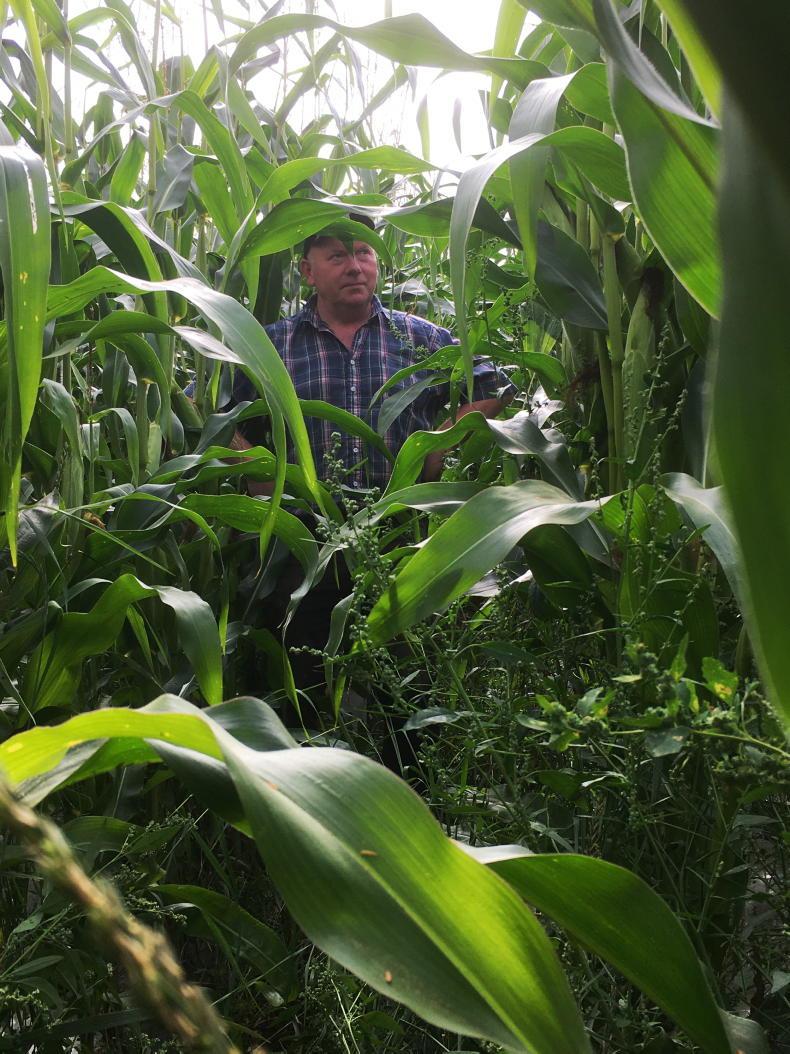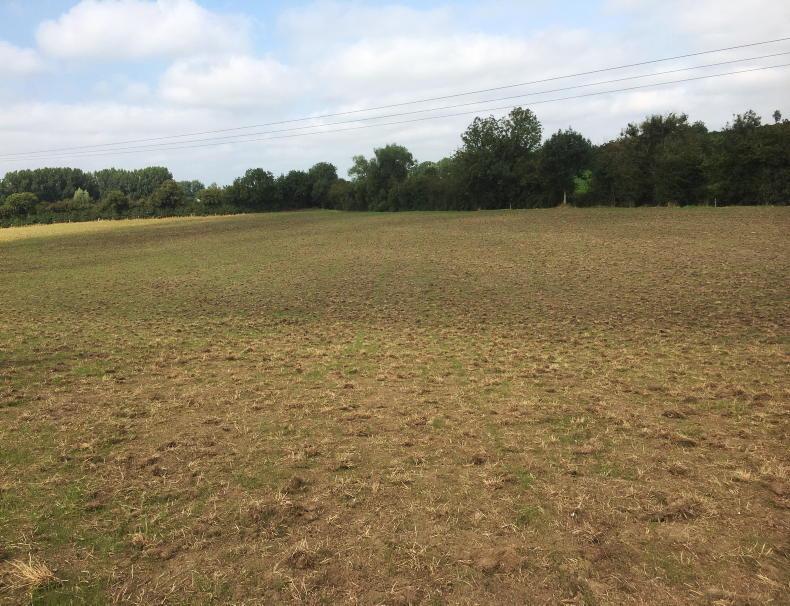Grass is continuing to grow strongly on Frank Goodman’s farm outside Carrickmacross in Co Monaghan.
The latest grass walk put daily growth at 53kg dry matter per hectare (DM/ha), well ahead of the seasonal average at this time of the year.
It means Frank is well placed to graze cows into November, if conditions allow.
In his first year, having moved over to a fully spring-calving system, Frank has a limited grazing area of 12ha around the yard, so cows are out by day and kept in at night.
An outside land block is zero-grazed, with cows getting ad-lib fresh grass at night along with 5kg of maize silage.

Frank Goodman's maize looks exceptional ahead of harvest.
While grass covers on the grazing paddocks are on target, covers on the zero-grazed block are heavier and approaching 4,000kg DM/ha (2,500kg in the ROI system).
“Ideally, we want to be going into the same covers of around 3,500kg DM/ha at this time of the year, whether it is in paddocks or zero grazing.
“If we go above 4,000kg, grass quality will drop, and any re-growth will be very slow,” maintains CAFRE Dairylink adviser Michael Verner.
To sustain growth into the autumn, the grazing paddocks on the Goodman farm received a last fertiliser application of 40 units (1.5 bags) of nitrogen per acre on 10 September, with land away from the yard receiving 35 units per acre.
In addition, around 50ac of the farm have also received an application of lime (2t/ac) this summer, after soil analysis carried out earlier in the year identified the need to correct pH.
Second cut
Frank has an abundance of silage in the yard, some of which was left over from 2020.
He was able to sell his second-cut silage either as bales or as a standing crop, with that land now into the grazing block.
Milk solids
At present, 102 cows are going through the parlour, yielding an average of 23.1l per day at 4.31% butterfat and 3.46% protein.
Milk solids have rebounded after a low reading in mid-season, when cows were approaching peak milk production.
Cows are currently producing 16l of milk from forage alone, and getting 3kg per head per day of a 16% protein concentrate in the parlour.
With plenty of grass, no concentrate is being fed to either in-calf heifers or heifer calves.
Maize silage
Frank has again grown 10ac of maize, and ideal growing conditions in 2021 mean the crop looks exceptional ahead of harvest, with good cob development.
He is now waiting on grain fill and hopes to ensile the crop in the next two to three weeks, although that might be pushed forward a little if there are any signs of frost in the weather forecast.
Reseed done
without ploughing
A total of 10ac was burned off on the Goodman farm in mid-summer, ahead of reseeding.
According to Frank, the land is stony, so rather than plough, he decided to use a set of discs to create a suitable tilth ahead of sowing.
Some drainage work was also completed, including the use of gravel tunnels.
Lime was applied at around 2t/ac to neutralise the acidic load created by a decaying sward (which could limit seed germination), with the seed incorporated using an Einbock drill on 13 August 2021.
The mix used included the top two varieties on the Teagasc Pasure Profit Index (PPI) for 2021, the tetraploids, Aberclyde and Gracehill, along with two diploid varieties also on the PPI list, Ballyvoy and Aberwolf.
The new sward has come through well and should be ready for a light grazing by calves in October, which will help to thicken out the sward.
Ahead of that, Frank hopes to get it sprayed for docks and chickweed this week.
The advice from Michael Verner is, if possible, to deal with weeds in autumn reseeds now, rather than wait to the spring.
“Docks are best dealt with at seedling stage, and while chickweed might not look bad now it can grow on over the winter and choke out new grass by the spring,” he said.
Shed improvements
on the farm
Frank has also undertaken some shed modifications over the quieter summer months in an attempt to improve cow welfare and comfort.
Some old-style Dutch Comfort cubicles in the milking cow house have been replaced with a Super Loop cubicle, while floors in the same shed have been concrete-grooved to provide additional grip.
Calf houses on the farm have also been washed and disinfected.
Read more
Low percentages a cause for concern
Tight calving paying dividends in Tyrone
Grass is continuing to grow strongly on Frank Goodman’s farm outside Carrickmacross in Co Monaghan.
The latest grass walk put daily growth at 53kg dry matter per hectare (DM/ha), well ahead of the seasonal average at this time of the year.
It means Frank is well placed to graze cows into November, if conditions allow.
In his first year, having moved over to a fully spring-calving system, Frank has a limited grazing area of 12ha around the yard, so cows are out by day and kept in at night.
An outside land block is zero-grazed, with cows getting ad-lib fresh grass at night along with 5kg of maize silage.

Frank Goodman's maize looks exceptional ahead of harvest.
While grass covers on the grazing paddocks are on target, covers on the zero-grazed block are heavier and approaching 4,000kg DM/ha (2,500kg in the ROI system).
“Ideally, we want to be going into the same covers of around 3,500kg DM/ha at this time of the year, whether it is in paddocks or zero grazing.
“If we go above 4,000kg, grass quality will drop, and any re-growth will be very slow,” maintains CAFRE Dairylink adviser Michael Verner.
To sustain growth into the autumn, the grazing paddocks on the Goodman farm received a last fertiliser application of 40 units (1.5 bags) of nitrogen per acre on 10 September, with land away from the yard receiving 35 units per acre.
In addition, around 50ac of the farm have also received an application of lime (2t/ac) this summer, after soil analysis carried out earlier in the year identified the need to correct pH.
Second cut
Frank has an abundance of silage in the yard, some of which was left over from 2020.
He was able to sell his second-cut silage either as bales or as a standing crop, with that land now into the grazing block.
Milk solids
At present, 102 cows are going through the parlour, yielding an average of 23.1l per day at 4.31% butterfat and 3.46% protein.
Milk solids have rebounded after a low reading in mid-season, when cows were approaching peak milk production.
Cows are currently producing 16l of milk from forage alone, and getting 3kg per head per day of a 16% protein concentrate in the parlour.
With plenty of grass, no concentrate is being fed to either in-calf heifers or heifer calves.
Maize silage
Frank has again grown 10ac of maize, and ideal growing conditions in 2021 mean the crop looks exceptional ahead of harvest, with good cob development.
He is now waiting on grain fill and hopes to ensile the crop in the next two to three weeks, although that might be pushed forward a little if there are any signs of frost in the weather forecast.
Reseed done
without ploughing
A total of 10ac was burned off on the Goodman farm in mid-summer, ahead of reseeding.
According to Frank, the land is stony, so rather than plough, he decided to use a set of discs to create a suitable tilth ahead of sowing.
Some drainage work was also completed, including the use of gravel tunnels.
Lime was applied at around 2t/ac to neutralise the acidic load created by a decaying sward (which could limit seed germination), with the seed incorporated using an Einbock drill on 13 August 2021.
The mix used included the top two varieties on the Teagasc Pasure Profit Index (PPI) for 2021, the tetraploids, Aberclyde and Gracehill, along with two diploid varieties also on the PPI list, Ballyvoy and Aberwolf.
The new sward has come through well and should be ready for a light grazing by calves in October, which will help to thicken out the sward.
Ahead of that, Frank hopes to get it sprayed for docks and chickweed this week.
The advice from Michael Verner is, if possible, to deal with weeds in autumn reseeds now, rather than wait to the spring.
“Docks are best dealt with at seedling stage, and while chickweed might not look bad now it can grow on over the winter and choke out new grass by the spring,” he said.
Shed improvements
on the farm
Frank has also undertaken some shed modifications over the quieter summer months in an attempt to improve cow welfare and comfort.
Some old-style Dutch Comfort cubicles in the milking cow house have been replaced with a Super Loop cubicle, while floors in the same shed have been concrete-grooved to provide additional grip.
Calf houses on the farm have also been washed and disinfected.
Read more
Low percentages a cause for concern
Tight calving paying dividends in Tyrone








 This is a subscriber-only article
This is a subscriber-only article










SHARING OPTIONS: